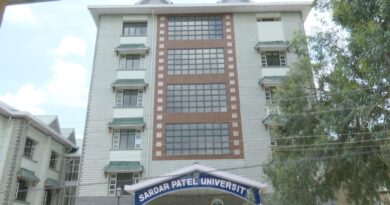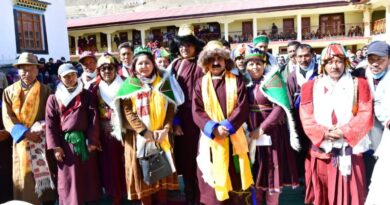Leh was a city of Lakes & Pangong lake originate from a river
The recent exploration by the Geo-scientists on the Himalayan Mountain ranges thrown a new light on the origin and dying of lakes, here.
In a couple of papers presented, experts explain that around 1000 years ago, ”’Leh was a city of Lakes’ and today’s ‘Pangong lake was a river and tributary of Shyok. This is the conclusion of the investigations carried out by the team of geologists and environmental students of Ladakh Science Foundation headed by Dr Ritesh Arya.
Dr Arya who has spent more two decades studying the impact of climate change on the water resources of Ladakh especially the groundwater based on the bore wells drilled said that the study found dying lakes in the Leh and Ladakh. Also the present days glacial bodies and lakes reveal interesting facts, he added.
Replying to a query why today’s Pangong lake has salty water Dr Arya said it is nothing to do with the Eurasia Sea’. ” Water is becoming salty after erosion of minerals with water of this lake and decreasing water level with the passage of time, in Pangong and other Himalayan lakes ” he informed.
These fresh water lakes were lifeline for the traders with their camels and horses on the OLD SILK ROUTE. The dynamics of these lakes changed due to climatic conditions and the end of these lakes happened due to unprecedented changes in climate, which ultimately led to the end of the Trade on the Silk route.
Replying to the query how climate change and Global warming impact the Lakes of Ladakh, he said their recent paper revealed that Lakes in the high altitude of cold mountain deserts of Ladakh have been center of attraction for everyone since time immemorial.
He added that in ancient times these lakes were the life line for the travelers moving along the ” old Silk Route whereas the Pangong lake became famous after the shooting of the ‘3- IDIOTS’ and the now escalated Indo- China tension.
“But what if one has to say that the lakes which were center of attraction in the past are today nowhere found and are extinct including the famous paleolake at DBO)Daulat Beg Oldi)- Shey Spituk and Lamayuru which is also known as the moon land on earth,” stated Arya.
Adding,” Besides, the present lakes of Pangong and Tsomoriri were rivers and tributaries of Shyok and Satluj in the past and are lakes of today.”
This has been revealed in an international conference on “EARTH AND ENVIRONMENT IN ANTHROPOCENE” (ICEEA-2021) by the team of geoscientists from Ladakh Science Foundation working under the guidance of Dr Ritesh Arya.
He said that in the paper ‘Climate change and Global warming: Impact on Lakes of Ladakh’ by Ritesh Arya, Mohd Ilyas, Kunzang Dolma and Tajalli Mohiuddin explains how the two climatic factors are impacting Glaciers in the Himalayas
Dr Ritesh Arya explained that glaciers in the Himalayas are either extinct or on the verge of extinction; this happened much before industrialization”.
According to World Bank report BOOK Glaciers of the Himalayas : Climate Change, Black Carbon, and Regional Resilience suggests that ”there are 55,000 glaciers in the Himalaya, Karakoram, and Hindu Kush (HKHK) mountain ranges that store more freshwater than any region outside of the North and South Poles.
These ice reserves feed into three major river basins in South Asia—the Indus, Ganges, and Brahmaputra—that are home to 750 million people. Melting glaciers and the loss of seasonal snow poses significant risks to the stability of water resources in South Asia”.
In the past during the Ice age the glaciers were massive and evidence of the Indus Glacier extending from Mansoarvar in the Himalayas to the Arabian sea were found in the bore wells drilled, asserted Arya. He stated that similar evidences of glacial recedes of more than 74 kms and 24 kms respectively have been found at Siachen and Khardungla.
Present paper highlights the impact of climate change, especially global warming, on the lakes located in the high altitude cold mountain deserts of Ladakh Himalayas.
“Pangong and Tsomoriri lakes of today in the Changthang region of Ladakh were once perennial tributaries of Shyok and Satluj respectively in the past,” stated the paper. Since the end of the Last Ice age around 11700 years ago, the impact of global warming led to melting of the glaciers.
Receding glacial melt decreased discharge in the tributaries and the natural blockage at Lukung resulted in conversion of perennial tributaries leading to the formation of Pangong lake.
The rates of recession of glaciers in those times were very high as compared to the present times. Sicahen glacier had receded more than 74 Kms and Khardungla more than 24 kms and is today confined to the peaks.
He stated that this claim is evident from the small lakes found at the South Polu today. Similar deposits in Shey indicate a paleolake formation in the past which was fed by the receding Stakmo glacier. But the lake dried due to lack of water from Stakmo catchment area. In Spituk, lake dried due to paleo-flooding event from Indus and cloud burst at Spituk. Adding, Seismic activity could also have triggered the breach of the lake wall leading to its rupture and final death of the once massive lake.
In Lamayuru, also known as moonland on earth, glacial lake was formed due to blockage of glaciers by mountains. “Over time this led to disintegration of shales into clay during cooling times and a lake was formed.” He informed.
Later the lake breached due to paleflooding activity induced due to global warming leading to increased discharge creating a hydrostratigraphic disequilibrium.
Dr Aya further stated that even Tangsay was no exception and here, the lake was formed due to blockage of glaciers from Changla at Tangsay. Later the temporary wall made of debris was not able to withstand the hydrostatic pressure breached at Durbuk leading to glacial lake outburst. “Glacial evidence is very well preserved in the valley,” he claimed.
Temporary lakes were also formed due to blockage of Indus at Phyang and Nimmu but their life was very limited as the flow of Indus and lake created a hydrostatic pressure which breached the wall leading to instantaneous death of those lakes.
This phenomenon was similar to the Leh floods of 2010 when river Indus was temporarily blocked by floods at Choglamsar and Nimmo for a few minutes.
Paper also analyses and establishes the role of Chortens/ Stupas and Manay walls constructed by man in response to mitigate and manage natural disasters caused due to glacial melt 1000 years ago when the floods from glacial melt dominated the scenario.
Today their actual role has been forgotten and is confined to religious rituals by the buddhists.
Need of the hour is protect and preserve these paleo glacial lake deposits so that the entire record of climate change is preserved for the scientists to study the changes climate has undergone since the last warming times in the high altitude region of Ladakh Himalaya.




